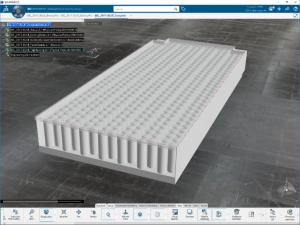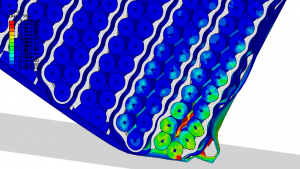With the rise in hybrid and electric vehicles, it’s important to consider the behavior and lifespan of the batteries that power these vehicles. How can we reduce the size of the battery cell without affecting the accuracy? Simulation can help.
Introduction
The li-ion battery is popular in electric vehicles, hybrid vehicles, as well as consumer products. In order to predict the structural and thermal behavior of a battery in an electric vehicle, a numerical model of the battery cell is required. Commonly, a large size of the detailed numerical model of the cell is used for the prediction of the accurate behavior of the battery cell. However, the detailed numerical model of the battery cell cannot be used in a module since the size of the module model becomes very large with the detailed cell model. As an example, for a cylindrical battery cell, one module has around 400 battery cells. One module can have more than 400 million elements if one battery cell has 1 million elements.

It is important to reduce the size of the battery cell while keeping the accuracy of the results in the module level. The homogenization of the jelly roll in a battery cell is one of the ways to reduce the size of the cell without affecting the accuracy.
Solution
By following Xu’s* research (see reference below), the Dassault Systèmes team used Abaqus and Isight to create the homogenized battery cell model. With the advantage of various material models in Abaqus, the proper material parameters can be optimized with the experimental data. To match the experimental data with Abaqus simulation results, Isight, the best tool in optimization and automation, is used. There are many components that can be used in various workflows in Isight. One of the important components is the data matching component, which is the tool to match the simulation result with the reference data. With the data matching capability in Isight, the correct material parameters can be obtained with the reference experimental data. With this workflow, proper the material model for the jelly roll can be obtained and the material model is dependent on strain, strain-rate, and SOC. With this homogenized approach, the size of the numerical model of the battery cell can be reduced by a factor of 200.

Using the homogenized battery cell model, several analyses can be done, such as static, vibration, random response, and drop analysis in the module level. As shown in the picture, the user can capture the equivalent plastic strain on the deformation of the jelly roll during the drop analysis. By observing the plastic equivalent strain, the short circuit phenomena can also be predicted. The developed battery cell model can be also used to estimate the static and dynamic stiffness of the module depending on SOC.

*Reference: J. Xu, B. Liu, X. Wang, D. Hu, Computational model of 18650 lithium-ion battery with coupled strain rate and SOC dependencies, Applied Energy 172 (2016) 180–189.
